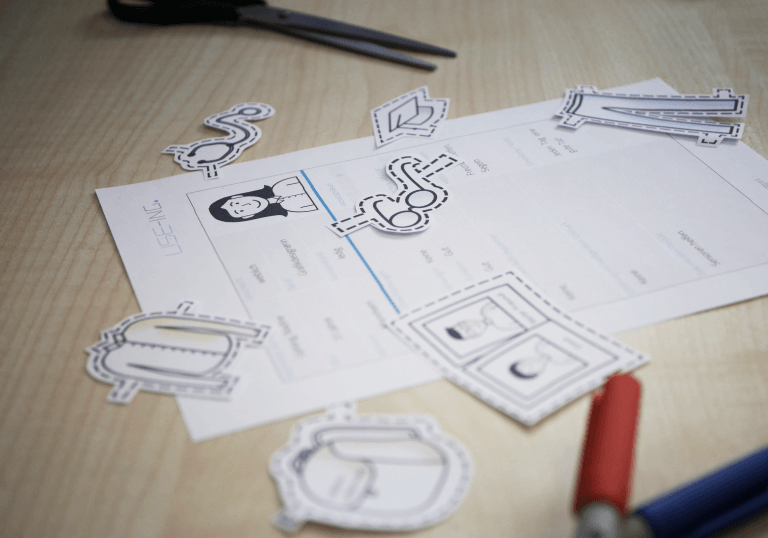They are based on the actual, current, or future user group, but do not depict a real existing person. The fictional but realistic persona helps developers to view their product from the user’s perspective and to identify with it. Therefore, personas aid in understanding the needs of the represented users and in generating solutions for the user’s interaction with the product.
Foundation of the persona
The persona is based on solid user research and requires a good understanding of the users. It should first be clarified who the current or future users are and what characterizes them. Various methods from the field of User Research can be used for this purpose, such as focus groups or contextual inquiry.
This subject area corresponds to the Empathize phase of the five-stage Design Thinking process, in which an understanding for the users is developed.
In the five-stage Design Thinking process, which consists of the phases Empathize, Define, Ideate, Prototype, and Test, the persona can be categorized into the “Define” phase. In the Define phase, the results of the Empathize phase are summarized, and user-oriented problems are analyzed and defined. The persona provides a way to summarize and represent these results so that they can be communicated well to all involved in the product development process.
In the usability engineering process in medical technology, the persona, alongside the purpose specification and the usage context, can be part of the Use Specification.
Usually, several personas are created to represent the diversity of users. The sensible number of personas depends on the heterogeneity of the users.
TIP:
„It is often useful to transfer not only the typical, most frequently represented users but also atypical users into personas. If the product is also to be usable for the atypical persona, both extremes and thus the spectrum between them can be considered in the development. For example, alongside a healthy persona, a persona with severe sensory limitations or a persona without expertise and a persona with above-average expertise can be developed.”
Many products have several user groups, such as in medical technology where doctors and surgical nursing staff often work with the same product in different ways. If there are different user groups, they should each be represented by one or more personas.
Structure of a Persona
Personas contain demographic data, including name, age, gender, and place of residence. The persona’s social environment is also of great relevance. For example, it can be stated whether time is spent with friends and what the marital status is. Another aspect is the values, attitudes, and goals in life.
Typically, the persona is accompanied by an image to give it a literal face.
Details about the professional background and education are also part of the persona. In addition to the profession, leisure activities are relevant, so that the observers, i.e., those involved in the project, can imagine a typical day of the persona.
Further questions to be answered by the persona are: Does the persona have sensory or motor limitations? Does she have illnesses or is she particularly fit?
TIP:
„Even very detailed information, such as wearing glasses, can be helpful later in the design process.”
Additional product-specific details, such as special prior knowledge and previous experience with the product or similar products, can be valuable information and are therefore useful components of a persona. Which additional aspects are integrated and how priorities are set in designing the persona depends heavily on the product. Overall, the persona should present a coherent overall picture.
Working with Personas
Personas serve as a communication tool between all project participants. They can standardize the understanding of users in the project team and define properties of the users to be considered.
Based on the personas, usage scenarios can be created in the further process, which depict the persona using the product to be developed.
Viewing the product from the perspectives of the personas, and thus the users, is useful, for example, in generating problem solutions or developing ideas for new features. Personas are also suitable for uncovering and understanding specific pain points or critical usage situations.
Additionally, personas can be used to assist in decision-making or prioritization of ideas in the development process.
If new insights about the user group or the product emerge over time, the persona should be reviewed for its currency and possibly adjusted.

